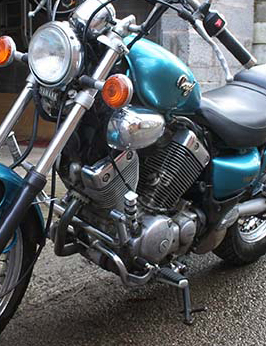24th June 2011
 Over on the NIBikers.com forum riders have voiced their concerns regarding the practice, at MOT test centres, that testers are lifting bikes fully onto their side stands to test front and rear wheels and bearings.
Over on the NIBikers.com forum riders have voiced their concerns regarding the practice, at MOT test centres, that testers are lifting bikes fully onto their side stands to test front and rear wheels and bearings.
It was reported that one rider who complained about their bike being lifted in this manner had his bike failed the MOT and is apparently appealing on the grounds that the test centre is not equipped with adequate stands to do the job properly or safely.
While side stands on bikes may seem robust, concerns were raised that side stands are not designed to support the weight of the bike in this manner and could snap or bend the frame and side stand mounting.
One rider commented that the side stand on his KTM is bolted to the engine case, with many owners buying a relocation kit to take the pressure away from this point.
While as a rider, you may be capable of carrying out this manoeuvre, it is your responsibility if something happens, e.g. you drop the bike. However would you let a total a total stranger do it? Who’s at fault as they would claim they had your permission.
At Right To Ride, we do what we do and have fired of a letter to DVTA (Driver and Vehicle Testing Agency) to highlight riders concerns that, “Motorcyclists pay a fee to have their motorcycles tested and would expect that the items on the motorcycle that require to be tested are tested in a safe manner, both for themselves and your staff and there is no risk that damage could be caused to their machines.”
 MOT MOT |
Our main question was, “What is the policy for MOTing a motorcycle that by design and is fully type approved, that does not have or indeed is not required legally to have a centre stand fitted”?
The DVTA sent a prompt response, “We appreciate that you have brought to our attention the practice of using the motorcycle side stands to raise the road wheels off the ground to assist in the inspection of components.”
They went on to say, “Lifting devices have been provided to raise motorcycles that have no centre stands fitted, however it is recognised that such devices are not suitable for lifting all types of machines.
 Where motorcycle road wheels cannot be raised safely from the ground, the examiner is limited to a visual inspection and assessment of components. The annual inspection is in the main a ‘visual inspection’, without any dismantling of vehicles or involving cumbersome processes, therefore there are a few types of motor vehicles and motorcycles which cannot be raised from the ground during the annual inspection.
Where motorcycle road wheels cannot be raised safely from the ground, the examiner is limited to a visual inspection and assessment of components. The annual inspection is in the main a ‘visual inspection’, without any dismantling of vehicles or involving cumbersome processes, therefore there are a few types of motor vehicles and motorcycles which cannot be raised from the ground during the annual inspection.
The inspection of motorcycles is due to be reviewed and it is anticipated that new and improved procedures and methods of inspection will be implemented.
DVA Health & Safety Section has now been made aware of this practice of using the motorcycle side stands to raise the road wheels off the ground and Test Centres have been informed that such a method cannot be used.”
Although the MOT test and issued certificate confirms that your vehicle at the time of its test (as far as can be reasonably determined without dismantling) met the minimum acceptable environmental and road safety standards required by law, it doesn’t mean that the vehicle is roadworthy for the life of the certificate and isn’t a substitute for regular maintenance.
With the promise of a review and new and improved procedures and methods of inspection to be implemented for motorcycles, at Right To Ride we look forward to a test that gives motorcyclists value for money for our test fees (Full Test £22.00 – Retest £14.00), will pick up any faults, without the risk of damaging our bikes or us or them! In other words a proper job!
Right To Ride would like to thank the DVTA for sorting out this issue and riders at NIBikers.com for raising and discussing the issue.
Information
NIBikers.com – www.nibikers.com
Hints and tips could keep you safe on the road at Ride It Right – Click Here
View videos of using the side stand:
On You Tube – Click Here
On You Tube – Taken to the extreme – Click Here
About the MOT on NIDirect – Click Here
Testing Items
These are items that we would consider need tested with either the front or rear wheel raised of the ground.
- With the front wheel raised off the ground the handlebar must not hit or foul the tank when the steering is fully turned lock to lock, the steering must move freely and without drag or notchiness.
- With the fork sliders held, try to push and pull on the forks, there must be no play in the steering head bearings.
- Check the wheel is free to rotate without brake drag in free-wheel.
- The tyre and wheel must run free in free-wheel nor must they foul the suspension or the mudguards.
- On bikes with swingarm suspension, there must be no freeplay in the linkage when moved from side to side.
- No play in the swingarm or suspension linkage bearings.
- Pivot bearings will be checked for wear.
- The chain/belt must not have excessive slack and be in good condition, the guard must be secure and not fouling.



Speak Your Mind